The images provided by the Hubble telescope have been a stunning achievement for the scientific community. However, the Hubble project was not without its share of problems. The development of the telescope took over a decade and billions of dollars . . . and it was almost lost due to a tiny flaw in the main mirror. The issues surrounding initial image clarity provided by the Hubble telescope are an excellent example of possible solutions that can be missed by limiting a search to the “root cause.”
To get a more detailed look at the cause-and-effect relationships that led to the Hubble focusing issues, we’ll use the Cause Mapping method. The Cause Mapping method also has three steps, but subtle adjustments to the outcome of each step make significant improvements, allowing more – and better – solutions. The three steps of the Cause Mapping process are 1) Define the problem, 2) Conduct the analysis and 3) Identify the best solutions. Each step will be discussed below.
Step 1. Define the Problem
The first step of the Cause Mapping approach is to define the problem. First, we ask four basic questions: What is the problem? When did it happen? Where did it happen? And how did it impact the goals?
The first step of the Cause Mapping approach is to define the problem by asking the four questions: What is the problem? When did it happen? Where did it happen? And how did it impact the goals? One person may say that the problem was that the telescope was out of focus. Another person might say that the problem was the flaw in the mirror. We can write down all the “problems” on the first line. In the Cause Mapping methodology, the facilitator anticipates that the group may disagree so all responses are written down. There is no need to spend time debating the problem. The magnitude of this incident is defined by the impact to the goals.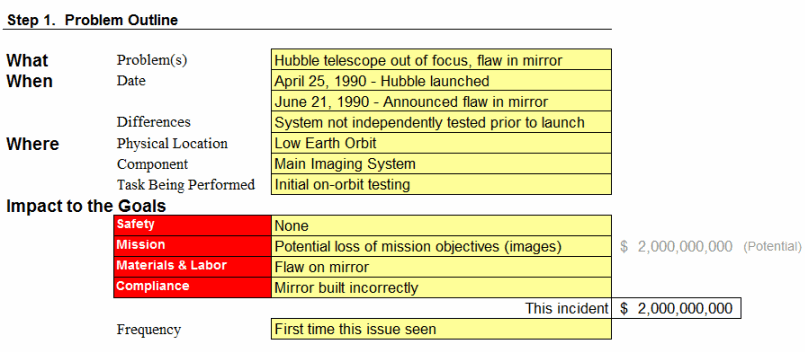
The second question is the “When?” which is the date of the incident. When captures the timing of the issue and also has a line for what was different or unusual in this occurrence. The question of what was different is fundamental in any investigation. On the Hubble issue, we capture two relevant dates: April 25, 1990 – when the Hubble telescope was launched – and June 21, 1990 – when it was announced that there was a flaw in the mirror. An important difference in the Hubble issue is that the telescope system was not independently tested prior to launch.
In an investigation, there can be several pieces of information that need to be captured when specifying the location. At a minimum, the physical/geographic location and the process should be captured. The physical location is where geographically the incident happened. In this case, the problem was realized in low earth orbit on the main imaging system of the telescope. The problem was discovered during initial on-orbit testing.
The next section is the impact to the overall goals. On this project (as with most projects) one of the overall goals is to have zero injuries. There were no injuries associated with the Hubble focusing issues. One of the other goals is to meet mission objectives. The images produced by the telescope were out of focus, leading to a potential impact on the Mission goal. (Approximately $2 billion had been spent on the Hubble so far – a big loss if the mission couldn’t be salvaged.) The material goal is impacted due to the flaw in the mirror, and the compliance goal is impacted because the mirror was built incorrectly.
Last we capture the frequency of the event. In this case, this was the first issue of this kind.
Step 2. Identify the Causes (The Analysis)
In the analysis step, the incident is broken down into cause-and-effect relationships which are captured on the Cause Map. We begin our Cause Map by writing down one of the goals that were affected as defined in the problem outline. For the Hubble, we begin with the impact to the mission goal.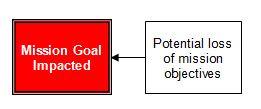
The analysis can continue by asking Why questions and moving to the right of the cause-and-effect relationship above. In this example, we’ll start with the potential loss of mission objects, which were caused by the Hubble images being blurred. The next question is “Why were the images blurred?”
The images were blurred due to a flaw in the primary mirror.
The flaw in the mirror occurred due to an error in the device used to shape the mirror because it was assembled incorrectly. Additionally, reliance on a single device to verify the shape and the fact that the flaw was not found prior to deployment due to a lack of independent testing resulted in the flaw in the mirror. All of these causes contributed to the flaw.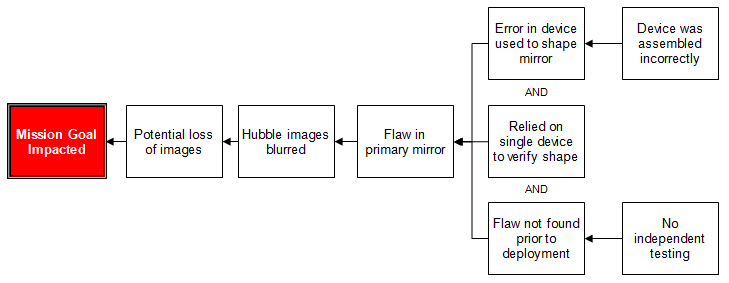
It is possible to add clarifying detail between causes, which can add more potential solutions and cause-and-effect reasoning. For example, we can add a cause between “Hubble images blurred” and “Flaw in primary mirror,” which is that light entering the instruments is off-spec.
In order for the images to be blurred, the light entering the instruments had to be “off spec”, but the instruments were “on spec”.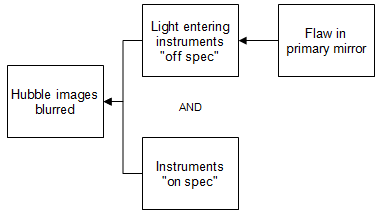
Step 3. Select the Best Solutions (Reduce the Risk)
Once the Cause Map is built to a sufficient level of detail, brainstorming of solutions can begin.
This is where the brilliant minds behind our space program realized that, since they couldn’t change the mirror, they could make adjustments to correctly read the “off spec” images being produced by the flawed mirror.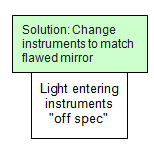
What’s particularly telling about this is that a billion dollar project was saved by “fixing” something that wasn’t wrong! A myopic focus on “the problem” or “the root cause” can limit solutions. Fully developing the cause-and-effect relationships that resulted in an issue is more likely to lead to better solutions. Remember, the best solutions may control a cause that’s not even considered a “problem”!
Learn More About the Hubble
View Hubble Video (or view on YouTube)
Read our blog on the Hubble focusing issues
Read our blog on the 2008 servicing mission
Cause Mapping Improves Problem Solving Skills
The Cause Mapping method focuses on the basics of the cause-and-effect principle so that it can be applied consistently to day-to-day issues as well as catastrophic, high-risk issues. The steps of Cause Mapping are the same, but the level of detail is different. Focusing on the basics of the cause-and-effect principle make the Cause Mapping approach to root cause analysis a simple and effective method for investigating safety, environmental, compliance, customer, production, equipment or service issues.
Click on “Download PDF” above to download a PDF showing the Root Cause Analysis Investigation.
Bring Cause Mapping® Root Cause Analysis training to your site
Schedule a workshop at your location to train your team on how to lead, facilitate, and participate in a root cause analysis investigation.
